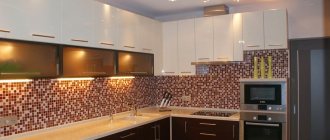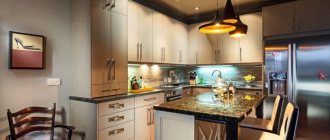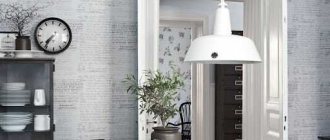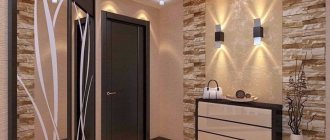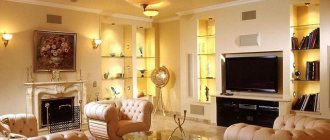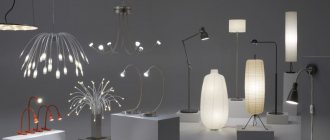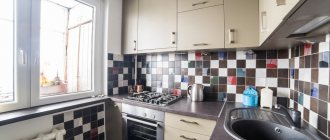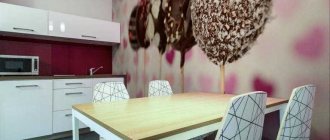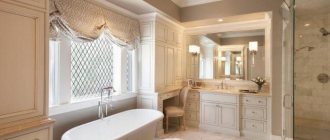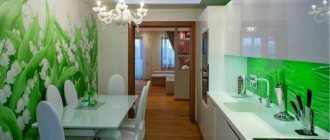Installing a stretch ceiling in the kitchen is a practical solution that allows you to create a perfectly flat surface at minimal cost. The coating is easy to maintain, durable, and able to protect the room from possible flooding by neighbors above. Properly designed lighting in a kitchen with a suspended ceiling can make the room not only spectacular, but also comfortable.
Stretch ceiling lighting in the kitchen
How the type and design of a stretch ceiling influence the choice of lighting
Lighting design is one of the most important elements in interior design. With its help, specialists place the necessary accents and ensure the proper level of illumination in the working and dining areas.
Depending on the tension materials used for finishing, their texture and technical characteristics, the visual effect of the installed lighting fixtures also changes completely.
Several options can be used:
- matte canvases successfully imitate a whitewashed surface without seams or defects, without a reflective effect;
- the satin material looks like it has been painted, so when installing ceiling lights nearby, beautiful reflections will be created;
- The varnished PVC canvas creates a mirror surface and reflects objects located below, so lighting fixtures will create additional effects.
In addition, suspended ceiling structures are often installed in a two-level design. This technique allows you to visually increase the height of the room, and additional lighting in their end part enhances the effect.
Proper lighting of the ceiling in the kitchen can visually change the perception of the room, highlighting its features with light (for example, original plasterboard niches, furniture elements).
Features of plasterboard ceilings
Universal drywall is an inexpensive, widespread and easy-to-process material. You will save much more money and time on leveling out level differences and removing old whitewash. And at the same time, a kitchen set with perfectly flat ceilings is much easier to select and install.
The box is easy to install even with your own hands and can be disassembled if desired. The additional layer improves sound insulation from neighbors above. To hide wires and pipes, you don’t have to ditch the ceiling, and even a large ventilation duct can be carefully disguised with plasterboard.
The plastic material easily changes shape: it can even be bent by first moistening and cutting it. This is another way to experiment with space and create original solutions in spacious rooms. The finished structure is completely environmentally friendly, and the top can be painted, plastered or sheathed with other material.
The main problem with drywall in the kitchen is its sensitivity to moisture. To do this, choose special moisture-resistant sheets with appropriate markings and use water-repellent paint. And at the same time, don’t forget about high-quality ventilation of the room, but in the kitchen you can’t do without it.
Kitchen lighting options with suspended ceilings
Two-level stretch ceiling in the kitchen
With the use of modern technologies for installing stretch ceilings, there are virtually no restrictions when developing lighting design. Installation of devices of any type and design features is possible. But an important condition for the successful completion of the task is to take into account all the features of the selected material (based on this, the optimal installation method is chosen).
When organizing kitchen lighting, the following principles apply:
- for installation, choose devices intended for installation in rooms with high humidity (the equipment body should not allow splashes, moisture, dust to penetrate inside and comply with class IP44);
- current regulatory requirements for illumination in different functional areas must be met (the average for general light is from 180 lux/m2, the work surface must be brightly illuminated, it is recommended to use warm spectrum lamps for the living area);
- lighting equipment is placed in such a way as to eliminate the possibility of shadows appearing in the functional area;
- The minimum distance from electrical equipment to the sink must be more than 60 cm.
It is necessary to take into account the color scheme used when decorating walls and furniture facades. When using light-colored materials, up to 80% of the light will be reflected. For small kitchens in Khrushchev this is the best option.
Local lighting in the kitchen with a suspended ceiling
Spotlights
Spotlights are compact devices that produce a narrow beam, which allows them to brightly illuminate only a limited area of the room. Placing a group of such devices in a room allows for sufficiently dense, uniform lighting.
Overhead and built-in models are available; you can use rotating devices to create light accents. Each type is very popular due to its ability to shape the lighting of a room of any geometry without shadow areas, and fit organically into almost any interior.
Spots
Spot is one of the types of point directional light devices. They are mounted on walls or ceilings.
Experts recommend installing equipment based on a power of 20 W/m2. If spots in the kitchen interior are used as a source of general lighting, it is recommended to install them at a distance of more than 30 cm from each other and no closer than 20 cm from the corner.
Spots in kitchen lighting
Chandelier
Designers recommend installing chandeliers in spacious kitchens in combination with other types of lamps.
Large structures can be used in the interior only if the ceiling height is sufficient so that they look organic and do not visually compress the space.
The chandelier can be placed in the center of the room or above the dining area. Its size depends on the dimensions of the room.
To determine the diameter of the chandelier, just add the length and width of the room in meters, and then divide the resulting amount by 10.
Decorative lighting
To organize decorative lighting in the kitchen, LED strip, neon tubes, and fluorescent lamps are used.
Their use is an effective design technique that allows you to highlight multi-level structures of suspended ceilings, plasterboard niches, and furniture. Less commonly, decorative lamps are installed at floor level (in this case, choose models that are equipped with high-strength glass).
Decorative lighting in the kitchen
LED panels
If it is assumed that the illuminated ceiling in the kitchen will be made in a modern style, installing an LED panel will be a laconic and functional solution.
It will provide excellent quality of light without ripples and flickering, while the equipment is highly reliable and has a long service life. The panels are compact, so they can be installed even when the distance between the tension fabric and the floor slabs is minimal.
LED panels in the kitchen
Glowing ceiling
Used in the manufacture of stretch ceilings from translucent or transparent PVC materials with or without photo printing on the surface. The light source is placed above their level and mounted directly on concrete slabs.
As a result, it is possible to create an interesting decorative effect. The luminous ceiling is equipped with fluorescent lamps and LED strips. They visually increase the height of the room, expand the space, and provide high-quality lighting throughout the entire area of the room.
Translucent stretch ceiling
How to install a busbar without tearing the fabric
First, you need to figure out how to install a track lamp if you use a mounting fastened in advance above the canvas. This is a simple solution that can be done even with minimal construction experience. The instructions look like this:
- The size of the busbar and its location are determined. First, a simple diagram with dimensions is drawn up. Then you need to mark the surface of the ceiling to indicate the position of the future structure.
- The wiring is laid in advance; it is better to use a flexible cable with copper conductors. The cross-section is selected according to the total power of the equipment; for concrete floors, special fasteners are used so that the wire does not sag and is held securely. Sufficient margin is left to connect the track.
- For installation, a wooden block or strip of suitable length is best suited. To set the optimal position, it is easier to use drywall hangers for mounting to the ceiling, since they can be bent as needed. The hangers are fixed with dowels to the concrete, and screwed to the block with self-tapping screws.
Metal corners are also suitable for fixing the timber. - After stretching the ceiling, you must first remove the wire; to do this, glue a plastic ring of a suitable size, inside of which a hole is cut.
Rings and glue for stretch ceilings. - Next, you need to glue washers through which you can screw in self-tapping screws to secure the magnetic busbar. Then the contacts are connected through a block or by soldering and the operation of the system is checked.
The overhead option is the easiest to implement.
By the way!
If you don’t have washers for the screws, you can stick pieces of tape on the ceiling and screw the fasteners through them.
Lamp layout diagrams
At the stage of developing ceiling lighting, it is worth considering several main criteria that determine the layout of the equipment:
- number and type of installed devices;
- location and dimensions of kitchen appliances and furniture;
- features of functional areas (dining room, work area);
- lighting standards.
When organizing lighting in a kitchen with a suspended ceiling based on photos illustrating projects successfully implemented by designers, many options are used. Especially when it comes to small point devices.
Schemes for the location of spotlights in the kitchen
Spot lighting
Spot lighting is a popular way of lighting design for a stretch ceiling. This is a system of built-in single lamps. Lamps are attached around the perimeter or along the edge of the protrusions.
This option involves many schemes and light compositions.
Spot lighting is optimal for zoning.
Organization of ceiling lighting in a small kitchen
Proper lighting is especially necessary for small rooms. It can visually change the perception of a room without redevelopment or other fundamental changes to building structures. To do this, it is important to correctly place the lamps, choose their number and design.
There are a few basic facts to consider when designing ceiling lighting for a small kitchen.
- Installing one large chandelier is a common mistake. In this case, the lighting will be uneven. It is worth dividing the room into zones and installing several devices in each of them.
- Illumination of the lower edge of the furniture along its perimeter will help to visually expand the space. This technique looks impressive, requires relatively little cost, and is suitable for most stylistic trends in the interior.
- Making the most of natural light will help make the room feel brighter and more welcoming. You should not cover the window with massive heavy curtains; it is better to pay attention to translucent lightweight materials.
- When installing spotlights in the kitchen, you can see from the photo that this type of equipment successfully copes with the task of lighting rooms with complex geometry.
- It is worth choosing lamps that generate natural light (especially when choosing task lighting). This will allow you to objectively evaluate the appearance of products and prepared dishes, and avoid incorrect perception of colors.
When developing a ceiling lighting project, it is important to focus not only on the convenience and decorative properties of the installed equipment, but also on its technical characteristics.
You should pay attention to the presence of a waterproof housing if the lamp is installed closer than 60 cm from a water source.
Lighting with spotlights for a small kitchen with a suspended ceiling
Types of lamps
Incandescent lamps. They are the cheapest, but have a number of disadvantages: they heat up and consume a lot. Not the best choice, fraught with high electricity costs.
Halogen. They give out a very cozy and sunny warm light, but also get warm. A buffer gas is added to them, and this can significantly extend the service life compared to conventional incandescent lamps.
Among such lamps there is a special category - metal halide , characterized by increased power. However, at home they are used extremely rarely. Mainly for commercial lighting of shop windows, at various exhibitions and museums.
LED. Significantly more expensive, but consume 5-10 times less electricity than halogen ones. In addition, they last a long time, heat up very little and can be of different light temperatures:
- warm - from 2000 to 3500K;
- neutral - from 4000 to 5000K;
- cold - from 5200 to 10,000K.
The same goes for energy-saving lamps. They also have similar effectiveness and approximately the same cost, and the only difference is a small amount of mercury vapor in the composition.
Which lamps do you prefer? It all depends on whether you want to have access to the dimming function (brightness adjustment). As a rule, this option is available to all halogen and incandescent lamps. But LEDs with dimming support cost a decent amount: if you have a lot of lamps in a track for your project, you will have to pay an amount quite comparable to the cost of the system itself.
Otherwise, LED lamps look like the most advantageous option in terms of price-quality ratio and output performance.
Important: when purchasing a track lamp, pay attention to whether it is equipped with a base that allows you to replace lamps. It can be threaded and then fit to it:
- incandescent lamps;
- LED
Or a pin one, which again is combined with LED lamps, as well as all types of halogen lamps.
Many models are of a non-removable type, so they need to be replaced along with the body. Of course, the option with a socket connector is much more convenient: you can always easily replace the light bulb and completely transform the lighting by choosing a different temperature.
Ceiling light in the kitchen-living room
The basic rule that designers follow when designing ceiling lighting for any kitchen-living room is the functional zoning of space.
The equipment is connected in such a way that the user has the opportunity to turn on or off the light in any part of the room, depending on need.
When installing a bar counter separating the kitchen and living room areas, the division of space with furniture should be delicately supported by pendant lamps located above it. A chandelier can be placed above the dining group. If desired, additional decorative lighting can be arranged using floor lamps, sconces, and table lamps. For local illumination of interior parts, directional light sources are used.
Lighting in the kitchen-living room with suspended ceiling
How to properly install spotlights
Installation of spotlights requires the preparation of certain tools and devices:
- Connection terminals;
- Flat-head screwdriver;
- Crowns for wood or metal (the latter will be required for working with slatted ceilings);
- Assembly knife for stripping wires;
- Drill;
- Wire cutters;
- Pliers;
- Ladder.
Connecting spotlights is impossible without creating the appropriate electrical wiring. At the first stage, the lighting box is installed - it is mounted in such a way that there is free access to it at all times. This means that you should not place the box behind the trim. After this, a separate wire is laid from the box to each lamp. The wires must be placed in a corrugated pipe, which is necessary for protection.
If you plan to place it in a plasterboard ceiling, then the work is carried out in the following sequence:
- The location of each device on the ceiling is accurately marked, while the location of the guides must be taken into account; lamps should not be attached to them;
- A hole of the appropriate size is cut out using a drill bit, and for square devices the hole is made with a jigsaw;
- The previously routed cable is pulled out through the hole. Of course, during work the wire must be de-energized. In order to be sure to remove the cable from a small hole, use a wire hook;
- The wire brought out is connected in accordance with the colors through the terminals. If you use LED lamps with screw terminals for the wire, then terminals are not required;
- Next comes the placement of the lamp in the hole, as a result of which it is secured with special spring clamps;
- A lamp is screwed into the device, and after that a decorative ring is put on;
- Conduct a system performance check.
Support the project - share the material with your friends on social networks:
Separating the dining and working areas using lighting
In a spacious room, it makes sense to divide it into a dining and working area. Depending on the specific use of space, experts recommend using different types of lamps.
- In the dining area of the kitchen, diffused soft light will be most comfortable.
- Work surfaces should be brightly illuminated using directional lights.
In order for the overall installed equipment to look organic and form an effective single composition, it is worth combining different types of equipment. One or several large-sized chandeliers are placed above the dining table; small directional spots and spotlights are used to illuminate the working surfaces.
Effective lighting of furniture, the perimeter of tensile structures, and end surfaces between ceiling levels is performed using LED strips. With their help, you can also emphasize the division of the room into functional zones.
You can use sconces only when the dining table is installed against the wall. Such devices are mounted at a height of 60-80 cm from the surface of the countertop.
Zoning a kitchen with a suspended ceiling using lighting
Types, facts and tips
- Types of spotlights for installation are divided into: mortise, surface-mounted, pendant. If mortise lamps can only be built into suspended ceilings (stretch, plasterboard, slatted, etc.), then overhead (external) lamps can also be installed on a regular concrete ceiling, since at the base of the body of such a spot there is a special mounting plate for screws;
- Built-in models are the most popular type in the category of spotlights, so they are presented in a very wide range of colors, designs and sizes;
- Recessed lamps can be completely recessed into the base and then they are practically invisible, or they can, on the contrary, decorate the ceiling, protruding above its surface with a beautiful decorative diffuser;
- Spotlights can create local, main and decorative lighting;
- Each of the installed devices is capable of illuminating no more than two square meters of the room;
- Modern devices are fireproof, and therefore can be used in combination with any finish. And their body is made of moisture-proof material, which makes it easy to withstand high humidity;
- There are designs with an internal or external location of the light bulb, which provides directional or diffused light, respectively.
Adviсe:
- The simpler the design of the spots, the easier it is to care for them - to wash off grease, dust, etc.;
- For suspended ceilings, it is better to choose lamps with round or rounded corners;
- For more economical and rational energy consumption, install a dimmer, which is also called a rheostat or dimmer.
The nuances of ceiling lighting depending on the design style of the kitchen space
When developing a kitchen design, one of the key points is lighting design. Depending on the chosen style in the design of the room, the types of lighting fixtures to be installed, their decorative design, and manufacturing materials are selected.
Combination of classic interior with modern types of lighting
Several main directions can be identified.
- Classic. To emphasize this direction in interior design, the ceiling light in the kitchen-living room should be soft but bright. For central lighting, luxurious chandeliers with glass pendants are chosen, and sconces are installed on the walls. When placing equipment, you should adhere to symmetry.
- Provence and country. The emphasis is on the abundance of soft light and air in the room. They use pastel shades in the interior, install chandeliers of original shape with bronze finishing and silver-colored decor. Style implies naturalness, so warm light lamps will help to organically fit the lighting into the overall picture.
- Modern styles. Originally shaped lamps, spotlights, split systems, diode strips, and lanterns will help to emphasize this stylistic decision in the interior.
There are no clear criteria when choosing lighting equipment. For example, a classic interior can be supplemented with an LED strip along the perimeter of a stretch ceiling. Each situation should be approached individually.
Kitchen lighting in a modern style
Requirements
Since suspended ceilings are a fragile material, several rules must be followed when handling them. The main thing that the canvas is afraid of is temperature: at 55 degrees Celsius it begins to deform. Therefore, the lamp, if it is a spotlight, must have a side to prevent overheating. And there are requirements for the lamps themselves :
- halogen - up to 35 W;
- incandescent - up to 60 W.
Fluorescent and LED bulbs have no limitations, since they practically do not heat up. Therefore, it is advisable to use only them; in addition to safety, it is also more economical.
When using incandescent or halogen lamps, it is not advisable to choose lamps whose horns point upward. This will prevent the canvas from possible deformation due to heating and fading of brightness.
There is another difficulty with these light bulbs: you should choose the lamp itself more carefully, because the metal parts can also heat up and damage the canvas.
The conclusion is this: it’s better to use modern lamp options - and you won’t have to worry about anything.
Photo examples of kitchen lighting with a suspended ceiling
Properly selected and placed lighting fixtures of different designs (you can use both classic chandeliers and small spotlights) can effectively emphasize the style of the interior and the architectural features of the room.
By installing a suspended ceiling with lighting in the kitchen, you can easily emphasize the design of the unit, divide the room into zones, and visually expand the room.
Original chandelier in the interior of a modern kitchen
Lighting in a classic style in a kitchen with a suspended ceiling
Chandelier in the kitchen with a suspended ceiling in Provence style
Stretch ceiling lighting with photo printing in the kitchen
Small kitchen lighting
Original design of kitchen lamps
When choosing a method of lighting a stretch ceiling in a kitchen, the types and location of lamps, it is important to focus not only on photographs of finished interiors, but also on creating a good level of illumination in each of the functional areas of the room. It is also recommended to pay attention to the functionality of the installed equipment: the ability to regulate the direction and power of the flow.
When installing a multi-level stretch ceiling and using translucent fabrics, additional opportunities arise for creating interesting decorative effects, taking into account the features of the chosen stylistic solution for kitchen design. There are many options, all that remains is to decide on the choice.
Choosing types of lighting fixtures
In addition to performing basic functions, lamps must comply with (or at least not contradict) the parameters and general style of the kitchen, the design of the ceiling, create coziness and meet energy consumption requirements.
And here are the lighting devices you have at your disposal:
- pendant - chandeliers, lampshades, spots or just light bulbs on a cord;
- built into the ceiling - spots, panel, modular, spotlights;
- overhead – tablet lamps, spotlights, spots;
- LED Strip Light;
- ceiling-mounted monochrome or RGB lighting.
If you are thinking about decorative lighting for two-level structures, the effect of a floating ceiling and a starry sky would be interesting solutions.
The interior style and size of the kitchen will help you choose the appropriate type of lamp. It is desirable that the lighting fixtures match the decor, are made from the same material and do not differ in color. Similar lampshades can be found from different manufacturers.
Mixing styles is in fashion, so don’t be afraid to go beyond your chosen direction. Lighting should be comfortable, even if it turns a classic interior into a neoclassical one.
Now let's go through each of the points.
Installation of a plasterboard ceiling in the kitchen
If you have never had experience in construction and repair work, it is better to turn to professionals to install a plasterboard ceiling. An improperly secured frame, a lack of hangers, the wrong fasteners, or uneven load distribution - all this can lead to subsidence and even collapse of the structure.
Fragile drywall requires careful handling because it is easy to break and damage. Do not use cracked sheets even after treatment with construction mixture or glue. The result will still not be strong enough and reliable.
In addition to regular and waterproof, plasterboard sheets are fire-resistant, high-strength, cardboardless and gypsum fiber. The set of tools for installation work is extremely simple: you will need metal profiles, hangers, fasteners, a level, a square, a tape measure, a hacksaw, a drill and a screwdriver with different attachments, a stepladder and a pencil.
Guide profiles are installed along the perimeter of the room, and perpendicular load-bearing elements are installed in them. Complex multi-level and shaped structures must first be drawn out. The profiles are attached to the ceiling with special U-shaped hangers. They are produced immediately with holes for ease of installation and level adjustment.
Screw the frame to the wall with a distance of 30-40 cm, and the hangers to the ceiling - with a distance of 60-70 cm. The maximum step between the screws with which you screw the sheets to the profile is 15-20 cm. To prevent the drywall from cracking, step back from the edge of the sheet approximately by 15 mm.
Before covering, lay pipes, wires and other communications in the frame. Make the wiring right away, stretch the wires to the switch and run the ends under the lamps. And make holes for them as you lay the sheets - it’s more convenient than drilling a completely finished ceiling. And if something goes wrong, the damaged sheet can still be easily replaced.
Plasterboard sheets are screwed to the frame strictly perpendicularly or parallel, and all joints and joints are sealed with reinforcing tape and putty. After this, all places are rubbed with sandpaper and sanded, and then you can move on to the exterior finishing.
Before filling the joints, wait a few days for the structure to settle completely. Clean and moisten the joint lines and fill them with mounting mixture. After this, press the reinforcing tape into it and plaster over it again.
For external coatings, special enamels and hydrophobic paints are best suited. You can cover the surface with PVC film: it is not afraid of moisture, stains and odors, and is easy to clean. Elements covered with film will interestingly decorate a designer multi-level structure.
How to add good light to a design
The light fixture must fit into the overall interior of the kitchen. Chandeliers, sconces and small lamps will help complement the design.
Light should be different in different styles
Tape and dot models are in harmony with the style of hi-tech, minimalism, and modernism. Glass and metal fixtures will complement the space.
If the design of the kitchen space is country or Provence, then lamps with an original shape are used. Forged models with candle-shaped lamps are suitable. The surface of the product is bronze or silver (imitation). For a rustic interior, chandeliers in the shape of flowers are used; such chandeliers will look interesting in a wooden house.
With a classic design, a crystal model or glass pendants will fit. Its sophistication will give the room a certain charm. The only drawback is that it is difficult to care for.
Loft style lamps are similar to street lamps.
Watch the video with stretch ceiling options and lighting design, you might like one of the options:
